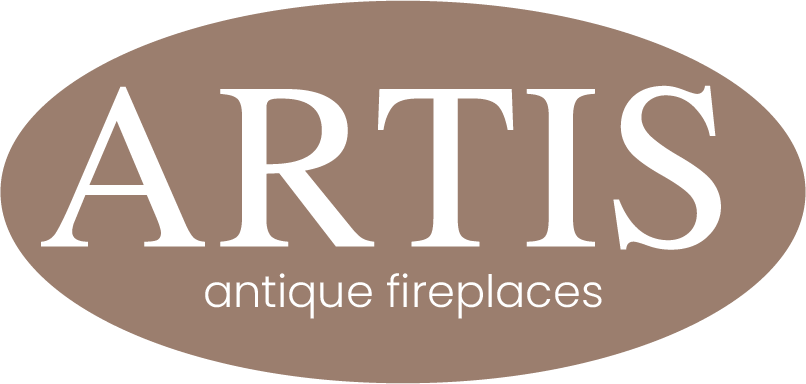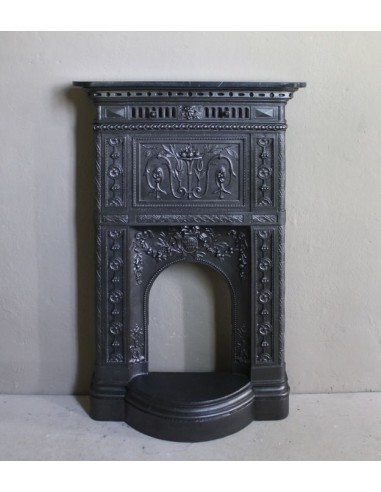The last time i saw a mantel of this model was about.....35-40 YEARS AGO (Gee...how cowardly time is, it runs taking care not to let you notice..).
WHEN I STILL HAD A NICE DARK FORELOCK (NOT QUITE LITTLE TONY STYLE BUT ALMOST..) AND BY NOW I THOUGHT THERE WAS NO MANTEL OF THIS SERIES AROUND ANYMORE.
AND SO, WHEN I SAW THE SPECIFIC MANTELPIECE THAT I AM PRESENTING TO YOU REAPPEAR, I SAW MYSELF AS A YOUNG MAN AGAIN, AS I WANDERED WITH ALMOST VOLUPTUOUS PLEASURE AMONG THE BUILDING SITES OF PARIS IN SEARCH OF FIREPLACES TO BE DISMANTLED..
THAT WAS A BELLE EPOQUE!!!
Whatever, better to let go of these memories, which bring melancholy, better to devote ourselves to illustrating in its many details this very rare and very fine fireplace.
First of all, it must be said that, of this model “PANIER FLEURI”, only the first mantels produced had a marble top while, after a few years of production, the Larcher family decided to replace the marble top with a cast iron one (which cost them much less) and so the majority of these fireplaces carry a cast iron “hat”.
WHY IS IT, YOU MAY ASK, THAT EARLY MODELS OF CAST-IRON FIREPLACES WORE MARBLE AND NOT CAST IRON?
Well, the reason is simple, and it concerns all the various models of cast-iron fireplaces of this illustrious and unsurpassed brand: Before the last years of the nineteenth century, there were no cast-iron hearth mantels, only marble, stone and wood mantel frames.
In order to be more likely to be liked by customers, considering that the fireplace mantel was considered by its owners to be no more and no less than a console table on which to place paintings, mirrors, clocks, daguerreotypes and various trinkets, the makers of these very modern and hitherto unknown cast-iron mantel frames proposed products that had a marble top shelf, a more familiar supporting surface than a cold and unknown cast-iron top. Then, as often happens, customers became accustomed to these modern and graceful fireplaces and accepted that the top could also be made of cast iron.
OUR FIREPLACE, THEN, WITH ITS VERY FINE BLACK MARQUINIA VEINED MARBLE TOP SHELF, IS TO BE CONSIDERED ONE OF THE FIRST MANTELS TO COME OUT OF THE FINEST FOUNDRY IN PARIS AND MOST LIKELY MADE IN THE LAST 10-15 YEARS OF THE NINETEENTH CENTURY.
Let us start with the face that appears in the center of the “band” at the top, where there are the two ‘valves’ that control the entry of air into the hearth, well this face is that of “”Vercingétorix," the Italic Vercingetorix, the French hero who most troubled Julius Caesar when he invaded Gaul, the Man who can be considered the French Garibaldi because, precisely in order to oppose the Roman army, Our Vercingetorix succeeded in unifying a good part of the barbarian tribes then inhabiting Gaul. Well, the first and highest decoration of this fireplace is precisely the face of our mythical HERO. Hence the fireplace's nickname.
Below the face of our HERO, a row of “balls” (you're such a crude ... that“row of little balls” is called “perlage workmanship”) acts as the upper mantel to a “small square” (also framed by “perlage”) in the center of which is represented a cornucopia (auspiciousness of abundance) of very fine design. And it will be this very special cornucopia, made of a goblet of the finest design from which comes a floral effluvium, also very refined, that will insert this fireplace into the great family of fireplaces “PANIER FLEURI”.
and, next to the cornucopia, two flowers turning on themselves (this symbolism also has meaning: The stars and flowers turning on themselves represent the Comet Star (a wish so that we do not lose our way in life).
Let us descend further and come to the blazon of the mythical Larcher Foundry, which blazon seems to superintend, dominating it, that very fine and arched mouth of the hearth...
Surrounding these two elements, a celestial arboreal saraband, oak branches and leaves (symbol and wish for Strength), olive branches and leaves (wish for peace par excellence) and even grape shoots with their fruit (wish for wealth and fertility, in short, a beautiful intoxication).
PARISIAN PROVENANCE, PERFECT STATE OF PRESERVATION, PERIOD LAST YEARS OF THE 19TH CENTURY.
“SHUTTLE” SERVICE FOR THOSE WHO THINK THEY ARE TOO FAR AWAY TO COME ALL THE WAY TO US.
Our exhibition is a 10-minute drive from the MEDIOPADANA high-speed train station. Fantastic, one would be inclined to say. In fact, in two and a half hours you can get to us from Roma Termini, in 50 minutes (and avoiding the mephitic chaos of Milanese roads) from Milan, in an hour and 40 from Turin etc.. We read a few pages of a good book, relax a little, all beautiful, no?!
Everything beautiful, even the station, fascinating work of modern art by arch. Calatrava, too bad that in order to get on the first available cab you lose at least an hour on the way there and another hour on the way back.... You can't have everything in the world, Italy is the most beautiful place in the world and we are happy to live there, though..
So, for a few years now, clients who decide to visit us by train, we have been waiting for them at the main exit of the Station and, of course, we take them back at the end of their visit. Some get embarrassed, would not want to be influenced to buy because of this “imposed kindness” of ours, and I can understand this feeling. That is why I would like to clear the field of this perplexity: It is physiological that a part of customers do not buy on the spot. Between husband and wife there is no agreement (maybe not only on the mantel..), they have found the right mantel but there may be a problem with measurements or they intend to get the placet from the architect on that particular color etc.. etc... Of this part of customers who do not buy on the first visit, almost all of them call back some time later confirming, by phone or email with attached photographs, one of the selected fireplaces. Another portion returns a second time, which is usually the good one. Very few are the “INCONTENTABLES” (from the 1960s carousels, remember?), those who will never show up again, but very few indeed. All this tirade to convey to those who will read these lines how we can accept without embarrassment a service that costs us practically nothing while relieving our possible customer of anger and wasted time that at a time that should be happy, just would be out of place.






























































